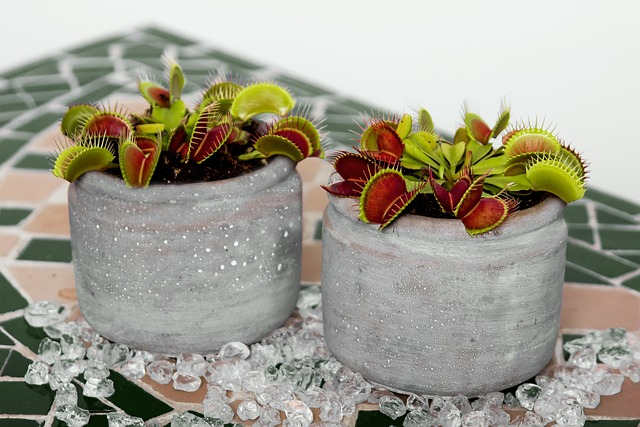In this article, it will get a little botanical. However, we are not just going to talk about any plant, we are going to have a closer look at carnivorous plants, which are plants that can capture and digest insects and other animals.

Nepenthaceahttps://pixabay.com/photos/pitcher-plant-nepenthaceae-362370/
Also known as insectivorous plants, there are more than 600 known species. They all have modified leaves that are the conspicuous trapping mechanism. These can either be passive or active. An example of a passive trap are pitcher plants. These have a hollow, lidded leaf which is filled with liquid to passively collect and digest prey. Flies and other small insects just crawl into the leaf and cannot get out anymore because of the sticky mucilage that all kinds of carnivorous plants have.
Active traps are for example the one from the Venus Flytrap. The Venus Flytrap uses rapid leaf movement to actively catch insects. A third kind of trap is only found in Bladdelwort plants. It is also an active trap that sucks in its prays with a vacuum.
The digestion of the caught animals works with enzymes or bacteria. It is actually not that different from the digestion in animals. The end products that can be used by the plant are mostly salts and nitrogenous compounds, which are not essential for the plants survival but are only an addition to the normal photosynthesis that most carnivorous species do.
The habitats of these plants are varied. They usually like their environment to be wet and low on nutrients. For example, bogs, swamps, watercourses, forests or sandy or rocky sites. They can be found all over the world, on every continent except Antarctica. Numerous species grow in Greece, such as the Pinguicula vulgaris, which is a plant with an active trap mechanism. They are also called Butterworts and as soon as an insect lands on them, mistaking the sticky mucilage for water or nectar, the leaf slowly rolls over and the plant starts to digest its prey. This kind of carnivorous plant grows from 4 to 15cm tall.
The largest carnivorous plant can grow up to 41cm tall with a pitcher capable of holding 3.5 liters of water. Scientists have observed vertebrates and small mammals in their digestive fluid. This means the biggest animal that carnivorous plants can ‘eat’ are small birds, reptiles or maybe even mice. We as humans, however, don’t have to worry. They can’t harm humans in the slightest and if you ever come across a carnivorous plant and you stick your finger in it nothing is really happening. If you move your finger around and trigger the tiny hairs, the trap will start to close, but this is pretty much it.

https://pixabay.com/photos/venus-flytrap-carnivorous-plant-595235/
In my opinion, these plants are fascinating and it seems like something nice to have at home in summer. Just imagine, you have a plant in your bedroom that eats all your annoying and unwanted mosquitoes. You need to have a little experience with plants, because if they don’t like the environment they will die, and this can be a little bit more challenging than keeping an average house plant. To provide them with the same conditions that they have in their natural habitat, you have to make sure not to just use normal soil. The best is to mix sand and peat in equal parts. Additionally, it also has to be well-draining and at the same time moist. Moreover, we need to create an environment with high humidity. Therefore, it is best to put the plant inside a terrarium with some air flow via a gap in the lid. Carnivorous plant also need indirect sunlight, and of course every now and then a fly or other insects to eat.
I hope that you learned some interesting facts about the only existing plant that eats meat. Also, have a lot of luck keeping them at home!
sources:
https://www.britannica.com/plant/carnivorous-plant (The Editors of Encyclopaedia Britannica 18.05.2023)
https://www.nhm.ac.uk/discover/carnivorous-plants-meat-eaters-of-the-plant-world.html (Kerry Lotzof, 25.05.2023)
